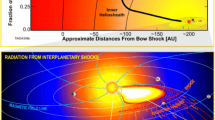Abstract
Future X-ray astronomy missions will be based on instruments with apertures much larger than those used up to now. Therefore, the risk posed by hyper-velocity dust grains in the space environment to the onboard instrumentation will increase, especially when a larger aperture is combined with a longer focal length. Starting from the lessons learned from the XMM and Swift satellites, we review the question of hyper-velocity impacts and discuss the expected impact-rate, risk of damage and possible mitigation strategies in the context of LOFT, eROSITA and ATHENA.

















Similar content being viewed by others
References
Strüder, L., et al.: Evidence for micrometeoroid damage in the pn-CCD camera system aboard XMM-Newton. A&A. 375, 5 (2001)
Abbey, T., et al.: Micrometeoroid damage to CCDS in XMM-Newton and swift and its significance for future X-ray missions, ESA SP-604, 943, (2005)
Smith, D., et al.: Flux and composition of micrometeoroids in the diameter range 1-10 microns. Nature. 252, 101 (1974)
Sørensen, J.: The LOFT radiation environment, ESA report, (2012)
Langwost, A., et al.: Presentation of the PC version of the ESABASE/debris impact analysis tool, ESA-SP-578, 619, (2005)
Feroci, M., et al.: The large observatory for x-ray timing, Proc. of SPIE, 8443, 8443-2D, (2012)
Zane, S., et al.: The large area detector of LOFT: the Large Observatory for X-ray Timing, Proc. of SPIE, 8443,8443-2F, (2012)
Brandt, S., et al.: The LOFT Wide Field Monitor, Proc. of SPIE, 8443, 8443-2G, (2012)
Igenbergs, E., et al.: The TUM/LRT Electromagnetic Launchers. IEEE Trans. on Magnetics. 22(6), 1536 (1986)
Zampa, G., et al.: The effects of hyper-velocity dust-particle impacts on the LOFT Silicon Drift Detectors, JINST,9, P07015, (2014)
Predehl, P., et al.: eROSITA on SRG, Proc. of SPIE, 9144,9144-1T, (2014)
Nandra, K., et al.: The Hot and Energetic Universe: a White Paper presenting the science theme motivating the Athena+ mission, arXiv:1306.2307, (2013)
Willingale, R., et al.: The Hot and Energetic Universe: The Optical Design of the Athena+ Mirror, arXiv:1307.1709, (2013)
Barret, D., et al: The Hot and Energetic Universe: The X-ray Integral Field Unit (X-IFU) for Athena+,arXiv:1308.6784, (2013)
Rau, A., et al.: The Hot and Energetic Universe: The Wide Field Imager (WFI) for Athena+, arXiv:1308.6785, (2013)
Meidinger, N., et al.: Experimental Verification of a Micrometeoroid Damage in the PN-CCD Camera System aboard XMM-Newton, Proc. of SPIE,4851,243, (2003)
Acknowledgements
The authors acknowledge support for the test campaigns at the dust accelerators from the Bundesministerium für Wirtschaft und Technologie through the Deutsches Zentrum für Luft- und Raumfahrt under grant FKZ 50 OO 1110. The results described in this paper have been reported during the AHEAD background workshop, organised with the support of the EU Horizon 2020 Programme (grant agreement n. 654215)
Author information
Authors and Affiliations
Corresponding author
Rights and permissions
About this article
Cite this article
Perinati, E., Rott, M., Santangelo, A. et al. Hyper-velocity impact risk assessment and mitigation strategies in the context of future X-ray astronomy missions. Exp Astron 44, 337–357 (2017). https://doi.org/10.1007/s10686-017-9546-1
Received:
Accepted:
Published:
Issue Date:
DOI: https://doi.org/10.1007/s10686-017-9546-1




